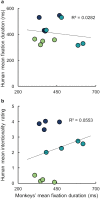No evidence that monkeys attribute mental states to animated shapes in the Heider-Simmel videos
- PMID: 33542404
- PMCID: PMC7862678
- DOI: 10.1038/s41598-021-82702-6
No evidence that monkeys attribute mental states to animated shapes in the Heider-Simmel videos
Abstract
Human Theory of Mind (ToM) is so automatic and pervasive that we spontaneously attribute mental states to animated abstract shapes, as evidenced by the classic Heider-Simmel findings. The extent to which this represents a fundamental characteristic of primate social cognition is debated. Prior research suggests that monkeys spontaneously predict behavior and attribute basic goals to conspecifics, but it remains unclear whether, like humans, they spontaneously ascribe mental states to animated shapes. Here, we address this question by analyzing rhesus monkeys' viewing patterns of the classic Heider-Simmel animations. We hypothesized that if rhesus monkeys also spontaneously attribute mental states to animated shapes, then, like humans, they would have the longest fixation durations for theory of mind animations, medium duration fixation for goal-directed animations, and shortest fixations for animations with random motion. In contrast, if attributing mental states to animations is specific to humans and perhaps other apes, then we predict no differences in looking time across animation categories. Unlike humans, monkeys did not fixate longer on ToM videos. Critically, monkeys' viewing patterns did not correlate with humans' viewing patterns or intentionality ratings from previously published research. The only major difference in viewing patterns between animation categories tracked differences in low-level visual motion. Thus, monkeys do not view the classic Heider-Simmel animations like humans do and we found no evidence that they spontaneously attribute mental states to animated shapes.
Conflict of interest statement
The authors declare no competing interests.
Figures




Similar articles
-
Gaze patterns and brain activations in humans and marmosets in the Frith-Happé theory-of-mind animation task.Elife. 2023 Jul 14;12:e86327. doi: 10.7554/eLife.86327. Elife. 2023. PMID: 37449983 Free PMC article.
-
Attributing social meaning to animated shapes: A new experimental study of apparent behavior.Am J Psychol. 2020 Fall;133(3):295-312. doi: 10.5406/amerjpsyc.133.3.0295. Am J Psychol. 2020. PMID: 33678806 Free PMC article.
-
When shapes are more than shapes: perceptual, developmental, and neurophysiological basis for attributions of animacy and theory of mind.Front Psychol. 2023 Sep 7;14:1168739. doi: 10.3389/fpsyg.2023.1168739. eCollection 2023. Front Psychol. 2023. PMID: 37744598 Free PMC article. Review.
-
Revisiting the Heider and Simmel experiment for social meaning attribution in virtual reality.Sci Rep. 2024 Jul 24;14(1):17103. doi: 10.1038/s41598-024-65532-0. Sci Rep. 2024. PMID: 39048600 Free PMC article.
-
The developmental origins of naïve psychology in infancy.Adv Child Dev Behav. 2009;37:55-104. doi: 10.1016/s0065-2407(09)03702-1. Adv Child Dev Behav. 2009. PMID: 19673160 Review.
Cited by
-
Seeing social interactions.Trends Cogn Sci. 2023 Dec;27(12):1165-1179. doi: 10.1016/j.tics.2023.09.001. Epub 2023 Oct 5. Trends Cogn Sci. 2023. PMID: 37805385 Free PMC article. Review.
-
Dogs Rely On Visual Cues Rather Than On Effector-Specific Movement Representations to Predict Human Action Targets.Open Mind (Camb). 2023 Aug 20;7:588-607. doi: 10.1162/opmi_a_00096. eCollection 2023. Open Mind (Camb). 2023. PMID: 37840756 Free PMC article.
-
Social prediction modulates activity of macaque superior temporal cortex.Sci Adv. 2021 Sep 17;7(38):eabh2392. doi: 10.1126/sciadv.abh2392. Epub 2021 Sep 15. Sci Adv. 2021. PMID: 34524842 Free PMC article.
-
Sound effects have only minor contribution to perceptions of anthropomorphism and animacy of simple animated shapes.Iperception. 2025 Feb 2;16(1):20416695251315382. doi: 10.1177/20416695251315382. eCollection 2025 Jan-Feb. Iperception. 2025. PMID: 39917280 Free PMC article.
-
Lesions to the mediodorsal thalamus, but not orbitofrontal cortex, enhance volatility beliefs linked to paranoia.Cell Rep. 2024 Jun 25;43(6):114355. doi: 10.1016/j.celrep.2024.114355. Epub 2024 Jun 13. Cell Rep. 2024. PMID: 38870010 Free PMC article.
References
-
- Scott RM. The developmental origins of false-belief understanding. Curr. Direct. Psychol. Sci. 2017;26:68–74. doi: 10.1177/0963721416673174. - DOI
Publication types
MeSH terms
Grants and funding
LinkOut - more resources
Full Text Sources
Other Literature Sources

